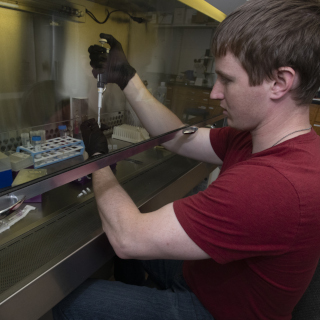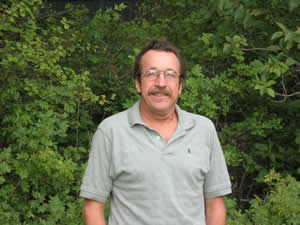Faculty and Research Areas
Faculty and Research Areas
The research conducted by University of Montana Molecular and Biomedical Sciences (MBS) faculty is diverse in scope. The following is a partial list of areas that you could pursue as a graduate student here at the University of Montana. We encourage you to access the web pages of the faculty associated with the research areas listed below, and contact them directly to learn more about their programs of discovery. All of these faculty members are currently involved in graduate training, and many have openings for new students in their laboratories.
If you are a faculty member with MBS, you can update your personal profile in the UM Employee Database.
William Holben
Professor Emeritus
Contact
- Office
- Health Sciences 503A
- Phone
- (406) 243-6365
- Bill.Holben@mso.umt.edu
Education
B.A. State University of New York at Fredonia, 1978
M.S. State University of New York at Buffalo, 1982
Ph.D. State University of New York at Buffalo, 1985
Research Interests
Molecular microbial ecology, molecular genetics, and environmental microbiology. Ongoing research projects include: Community-level analyses linking bacterial community structure, function, activity and diversity in metal-contaminated and pristine river sediment systems; exploring the role of the microbial community in the success of invasive weeds; examining the role of charcoal from forest fires in controlling the distribution and activity of nitrifying bacteria in forest soils; fate and transport of microbes in the environment; microbial ecology of the gastrointestinal tract; using the soil bacterial community as an early warning system for elevated CO2.
Field of Study
Molecular microbial ecology
Selected Publications
Kovacik, W.P. Jr., K. Takai, M.R. Mormile, J.P. McKinley, F.J. Brockman, J.K. Fredrickson and W.E. Holben. 2005. Molecular analysis of deep subsurface cretaceous rock indicates abundant Fe(III)- and So-reducing bacteria in a sulfate-rich environment. Environ. Microbiol: doi: 10.1111/j.1462-2920.2005.00876.x
Mummey, D.L., M.C. Rillig and W.E. Holben. 2005. Neighboring plant influences on arbuscular mycorrhiza fungal community composition as assessed by T-RFLP analysis. Plant and Soil: 271:83-90.
Holben, W.E., K.P. Feris, A. Kettunen, and J.H.A. Apajalahti. 2004. GC fractionation enhances microbial community diversity assessment and detection of minority populations of bacteria by denaturing gradient gel electrophoresis. Appl. Environ. Microbiol. 70:2263-2270.
Feris, K.P., P.W. Ramsey, M. Rillig, J.N. Moore, J.E. Gannon, and W.E. Holben. 2004. Determining rates of change and evaluating group-level resiliency differences in hyporheic microbial communities in response to fluvial heavy metal deposition. Appl. Environ. Microbiol. 70:4756-4765.
Callaway, R.M., G.C. Thelen, A. Rodriguez, and W.E. Holben. 2004. Soil biota and exotic plant invasion. Nature 427:731-733.
Feris, K. P. Ramsey, C. Frazar, J.N. Moore, J.E. Gannon, and W.E. Holben. 2003. Differences in hyporheic zone microbial community structure along a heavy metal contamination gradient. Appl Environ. Microbiol. 69:5563-5573.
Apajalahti. J.H.A., A.Kettunen, P.H. Nurminen, H. Jatila, and W.E. Holben. 2003. Selective plating underestimates abundance and shows differential recovery of Bifidobacterial species from human feces. Appl. Envir. Microbiol. 69:5731-5735.
Feris, K.P., P.W. Ramsey, C. Frazar, M.C. Rillig, J.E. Gannon, and W.E. Holben. 2003. Structure and seasonal dynamics of hyporheic zone microbial communities in free-stone rivers of the western United States. Microb. Ecol. 46:200-215.

